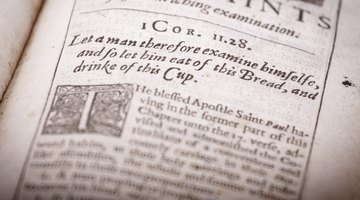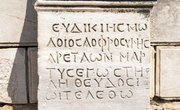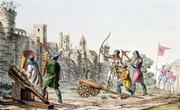For many people familiar with classics like "Beowulf" and "The Wanderer," the term "Old English poetry" calls to mind long, rambling epics about knights, battles, heroes and lovers. To be sure, the Old English and Anglo-Saxon poetic tradition has a specific tenor and subject matter. However, despite its somewhat antiquated tonality and style, the characteristics of Old English literature and poetry have endured and continue to impact the art form to this day.
What Is Old English?
In its most basic definition, Old English is the language spoken and written by the Germanic inhabitants of England. Their contributions to the history of letters begins in the 5th century and dates until the very end of the 11th century. Also called "Anglo-Saxon," Old English is the language in which all literature from what was then known as England was written.
The language itself is divided into three separate but distinct dialects. There is the Kentish dialect, the West Saxon dialect and the Anglian dialect. Because the West Saxon dialect was the language of the ruler Alfred the Great, it attained the greatest prominence. It is likely that the large majority of Old English texts that have survived from this period are in this dialect for that reason.
Old English began to develop and change as all languages do when pressure from external forces, invaders and expansion is brought to bear on the original vocabulary and syntax. For its part, West Saxon dialect began to drop syllables as it evolved, making the sounds simpler and more manageable to foreign tongues. Some of the finest examples of Old English literature are its poems, which still remain powerful and important cultural contributions to this day.
What Defines Anglo-Saxon Poetry?
Anglo-Saxon poetry can be difficult to describe to anyone who has not read it. Translated as much of it is into contemporary-adjacent English, the discernible characteristics are not in the meter or rhyme scheme as much contemporary poetry is today. Rather, what makes Old English poetry compelling is its characteristics and its subject matter.
In almost every extant case, the Old English poetry that has survived is limited to epic stories of battles fought and won and enemies defeated. The most famous of these and one of the oldest remaining pieces of Old English literature is the epic poem "Beowulf." While upon first glance the poem reads like prose, it is clear when examining the line structure and the repeated alliteration that the book is actually a long poem.
"Beowulf" is a sprawling epic that tells the story of a son born to the man who became king of the Danes and who freed the Danish people from a mighty beast. The story is told as it pertains to the goings on at the royal court, where Beowulf regales the assembled with tales of his adventures. This sort of hypermasculine adventure relating is characteristic of Old English poetry. The boasting, prideful relating of bold adventures to a court of royals who largely stayed in the palace grounds and faced little mortal danger is similar to the fascination that contemporary rappers receive for their stories of violent exploits.
What Are the Two Types of Old English Poetry?
Old English poetry is typically characterized in two ways. There is the heroic poetry of the Germanic pre-Christian period, which was largely of an oral tradition. There is also the Christian variety. Historically, the Saxons had a tradition of oral poetry, but it was the advent of Christianity that offered the opportunity to place these stories down in writing.
When historians began to dissect the particulars of Old English poetry, there was no real discernible guide to analyze. Scholars have debated the characteristics of Old English poetry for many decades and will likely continue to do so. The theories change and are based on a variety of information, mostly related to the new ways that scholars are processing the material that remains.
For novices, looking at Old English poetry in an anthology is a good place to begin familiarizing yourself with the world of Anglo-Saxon poetry. However, it is a good idea to learn a little bit about the characteristics of the literature before you start to read. There are some key characteristics of the genre that are worth your awareness, given that the poetry is often dense and can seem laborious and complicated to modern readers.
What Are the Main Old English Poetry Characteristics?
The major characteristic of all Old English poetry is the celebration of the warrior, the adventurer and the conqueror. This content makes up the vast majority of subject matter in most Old English poetry. Thematically, these poems concern the same issues modern writers speak of today. Good vs. evil, the power of the underdog, bravery, the service of a higher power and the ultimate separation of man from his comrades in death.
Linguistically, there are several characteristics that are definitive of the form. The first is alliteration. In the same way that much contemporary poetry relies on rhyme and meter to establish itself, Old English poetry relied heavily on the phenomenon of literary alliteration. Alliteration is defined as the repetition of a key consonant at the beginning of a word, such as "rare, red-skinned rabbits." This alliteration is key to understanding the poem's structure.
In terms of the structure of a poem, Old English poetry has a distinct sort of line and meter. Lines in Old English poetry are broken into two sections. These are called half lines, or verses. Between each is a pause. These two lines have "feet," the determination of the stressed and unstressed syllables. This is what determines the meter of the verse. Instead of rhyme connecting the verses, it is the stressing and the dropping of stress on various words and syllables that produce meter and rhythm.
Why Study Old English Poetry Today?
There are many reasons to study Old English poetry. Many of the characteristics of Old English poetry exist today in new forms and new ways. You need look no further than contemporary rap and hip-hop music to see that similar impulses drive poetry today, such as the urge to tell a story using meter and rhyme, the desire to brag or boast about conquests and achievements and the impulse to relate stories of daring or adventure.
The cheeky sort of wordplay that is characteristic of poetry and rap in modern times was also reflected in Old English poetry. Kenning, or combining two different terms that together create a metaphor, is a very important characteristic in Old English poetry. By combining two terms that have already-established meanings and creating a term that means something else, the language takes on additional richness. Calling a boat a "wave horse" or the ocean a "whale way" are both examples of this device.
Studying Old English poetry regardless of your own ethnic background is a wonderful way to connect to truth and information about the literary traditions that connect us all. Despite the Anglo prominence in the Western world, the study of Old English poetry can help to illustrate the way that similar themes, styles and topics of storytelling are shared all over the world.
Related Articles
References
Writer Bio
Ashley Friedman is a freelance writer with experience writing about education for a variety of organizations and educational institutions as well as online media sites. She has written for Pearson Education, The University of Miami, The New York City Teaching Fellows, New Visions for Public Schools, and a number of independent secondary schools. She lives in Los Angeles.











